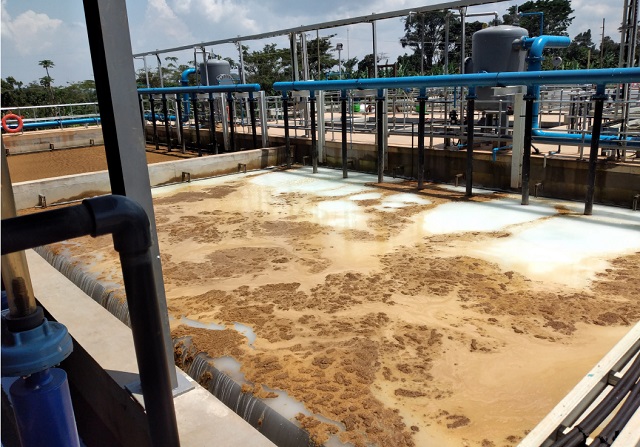
Katosi water works
The water is pumped from half a kilometre inside Lake Victoria at Katosi. About 11 metres below the lake surface, a huge pipe measuring about 1.5 metres in diameter gulps millions of litres of raw water every day. This water then gravitates into the treatment plant where it is treated with chemicals. It is then transported in huge sky-blue pipes via several villages onto the nearby reservoir perched atop Nsumba hill.
From here, the water cascades downhill through the villages and small towns of Ntenjeru, Kisoga, Kyetume and Mukono. At Seeta, the pipeline takes a detour to Sonde and proceeds to Namugongo where two standby water pumps have been installed. From Namugongo, the water is transported to the Naguru reservoir and is ready for distribution to homes.
The Katosi plant has been fitted with the latest technology to deal with the water quality challenge. Eng. Alex Gisagara, the director Engineering Services explained to the water minister that the plant uses the “dissolved air floatation technology” which is more suitable for raw water predominant with algae and low turbidity.
“This technology quickly removes impurities and algae from the abstracted water by using sand filters before the water is disinfected and supplied to the distribution network,” he said, adding that the Katosi plant has a very low foot print, uses minimal chemicals in the treatment process and less power because of the highly efficient process and equipment.
Why Katosi came on board
The challenge of rapid urbanization due to growing business and industrial activities around Kampala where the population since 2019 has been growing every year by 5% had created pressure on existing facilities at Ggaba.
Kampala, which until recently covered only the northern shores of Lake Victoria and spread out covering about 189 sq km, is now a sprawling metropolis of about 1,000 sq km. It is not only Uganda’s capital city but also serves as a commercial and industrial hub.
The deteriorating water quality in the inner Murchison Bay at Ggaba also posed a big challenge to the National Water and Sewerage Corporation’s task of supplying water at a cheaper cost.
At the beginning of the millennium, the top managers convinced the government to build a new water treatment plant. This plant would serve the eastern suburbs of the metropolis which were suffering from intermittent water supply.
Feasibility studies prepared in 2003 had earlier suggested the option of constructing another treatment plant in Ggaba. This proposal was, however, later dropped because the deteriorating water quality challenges in the inner Murchison Bay at Ggaba, which would further increase the water treatment costs at Ggaba. The Master Plan carried out in 2009 and later updated in 2014 recommended the construction of a water treatment plant in the east of Kampala.
Funded by the European Union Africa Infrastructure Trust Fund, the European Investment Bank, the Agence Francaise de Development (AFD) and Kreditanstalt für Wiederaufbau (KfW) at a cost of €82.2 million, the Katosi Drinking Water Treatment Plant and Katosi-Kampala Transmission Main Projects are part of the wider KW-LCWATSAN Project, whose objective is to improve the living conditions of the residents in the Greater Kampala Metropolitan Area through provision of safe and reliable water supply services.
Going forward, Mugisha says the sustainability of the Katosi water treatment plant will depend on the environmental protection of the zone where the new water works are located. “We shall work with the National Forestry Authority to protect this area to make sure that the source is very well protected.”
“We shall do this through greening the environment so that the pollution issues that have plagued Murchison Bay don’t reach here and we start spending a lot of money on chemicals.” Already, the National Forestry Authority has given 40 hectares along the shoreline to ensure the area is planted with trees. (⏩ Pg 3)
 The Independent Uganda: You get the Truth we Pay the Price
The Independent Uganda: You get the Truth we Pay the Price


